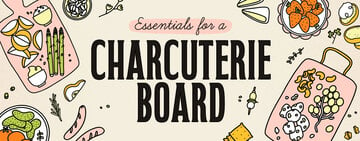Pickles are a classic refrigerator staple, but when you go to the grocery store, you may be overwhelmed by all the different types of pickles available. Each type of pickle is canned and preserved in a unique way, resulting in distinct flavors, textures, and, therefore, uses! Below, we break down the different types of pickles that have stayed fan favorites for decades.
Shop All PicklesTypes of Pickles
The many different types of pickles are beloved and favored for their distinct qualities. Their features range in both size and flavor. Below is a list of types of pickles with pictures to help you identify their differences:
1. Dill Pickles

Dill pickles are the most commonly known pickle type. Dill pickles include vinegar, pickling salt, and dill in its brine, whether it be fresh, dried, or in seed form. Dill pickles can also be prepared to be Kosher certified.
Found in many different pickle cuts, dill pickles are sold in whole, spear, chip, or slice form. Dill pickles can be used on or alongside sandwiches, burgers, and hot dogs. They also make great concession stand snacks when served alone in its whole form on a stick or battered and deep-fried in its chip form.
2. Full Sour Pickles

Sour pickles are one of the pleasantly sour types of pickles that are actually lacto-fermented instead of pickled. This means that there is no vinegar in their brine like in a dill pickle brine, and instead solely relies on salt, water, and time to achieve the desired flavor.
Because full sour pickles are fermented instead of pickled, they are full of healthy probiotics, making them ideal for snacking!
3. Half Sour Pickles
Half sour pickles undergo the same fermentation process as full sour pickles. However, to create a more mild flavor, half-sour pickles only ferment for half the time as full sour pickles. Fermentation times depend on the company, but it can range anywhere between a week or a few months.
4. Sweet Pickles
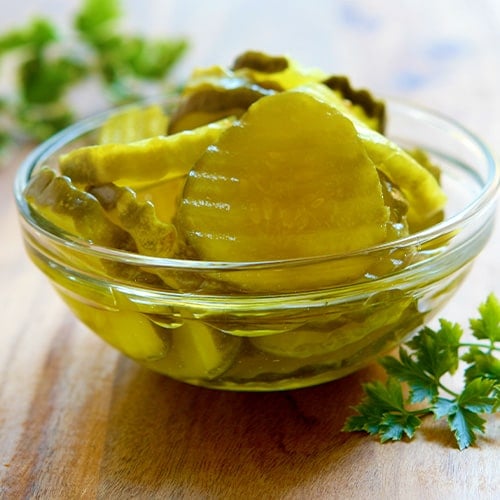
Sweet pickles are made just like dill pickles but have a low amount of sugar added to the brine mixture. Sweet pickles are not to be confused with candied pickles: pickles packed in a syrup-like brine.
Because of their dynamic flavor profile, sweet pickles can be used in so many different applications: layering into a sandwich to add a sweet tang, stuffing into olives, chopping up into a relish to spoon onto hot dogs, or eating by themselves as a simple snack.
5. Bread and Butter Pickles
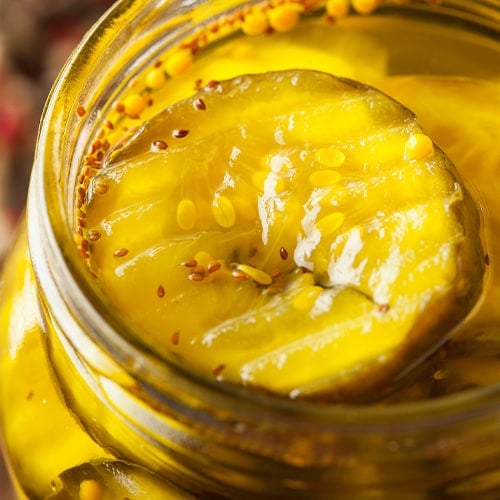
Bread and butter pickles are a type of sweet pickle. These pickles are a true fan favorite, usually sold crinkle-cut into pickle chips. Bread and butter pickles usually have a few more inclusions than sweet pickles – none of them actually being bread and butter of course. These extra ingredients are usually onions, green or red peppers, and various seeds from coriander, mustard, and celery plants.
Most commonly available in chip form, bread and butter pickles are made for piling high on juicy burgers or sandwiches with a beautiful cross-section. They’re also great fried or served alongside Texas-style BBQ.
6. Gherkins
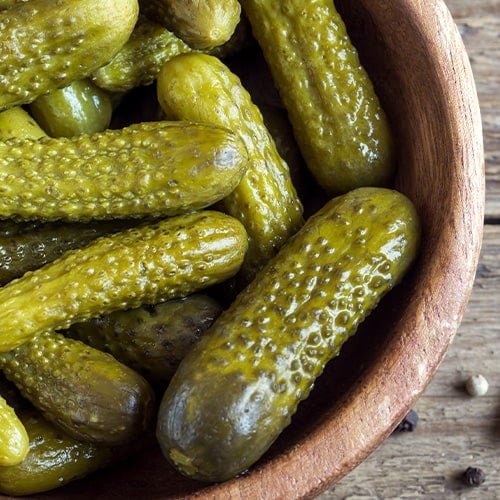
Gherkins are a type of pickle that is smaller than an average cucumber. These are usually made with young cucumbers, Kirby cucumbers, or Persian cucumbers. Gherkins can be sweet or savory, and they are usually crunchier than a dill pickle.
Gherkin's small but mighty stature makes them perfect for slicing up and layering on sliders, cutting into spears for a Chicago-style hot dog, or dicing and folding into potato salads or tuna salads.
7. Cornichons
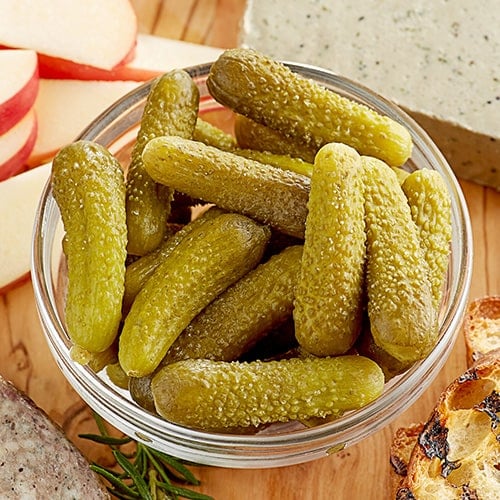
Cornichons are a type of pickle that is even smaller than a gherkin, usually around two inches long or less. These French-style pickles are tiny yet pack a big punch flavor-wise with a stand-out acidic flavor.
These pickles are perfect for making charcuterie boards, accompanying steak tartare, or serving alongside pate or terrine of foie gras. Their extra small size also makes them perfect for garnishing cocktails!
8. Pickled Peppers
Besides cucumbers, peppers are another perfect fruit to pickle (yes, cucumbers and peppers are fruits!). Almost any pepper can be pickled, so there is a large variety to choose from with a range of Scoville units. Below are the most popular pickled pepper varieties:

- Pickled Jalapenos - Pickled jalapenos have a very high heat flavor. They’re best used in different Mexican dishes, such as tacos and nachos, and are also popular on pizzas.
- Pepperoncini - These Greek and Italian pickled peppers have a green-yellow hue and medium heat level. Pepperonicini work well in antipasti and Mediterranean-style dishes.
- Banana Peppers - Banana peppers get their name from their long and bright yellow banana-like look. They’re pretty mild as far as pickled peppers go, and pair very well with meats, especially with cold cuts on sandwiches or tossed in a tuna salad.
- Cherry Peppers - Cherry peppers look like heart-shaped cherries and have a fiery red hue. Their spice level can range from mild to very hot, and are great stuffed with cheese, tossed in a pasta salad, or as a topping on pizza.
9. Specialty Pickles

While cucumbers and peppers are the most popular produce to pickle, the preservation doesn’t stop there. Vegetables that can be pickled are beets, cauliflower, onions, okra, carrots, and really any hearty vegetable. There are even popular pickled mixes such as giardiniera!
Pickling isn’t just limited to vegetables. Fruits, eggs, meats, and fish have been pickled for centuries, preserving the delicacies and curating an even more flavorful end product.
How are Pickles Made?
Check out our video to learn about the three methods of pickling:
Pickles are made by submerging food in an acidic liquid. There are three different ways to go about pickling: refrigerated, processed, and fresh-packed. Below are the three pickling methods to use, each creating its own distinct flavor and texture:
- Refrigerated: Fresh cucumbers are submerged into jars with a pickling liquid of water, canning salt, and pickling spices and immediately put into the refrigerator. Pickles made with the refrigerated method produce ultra-crispy pickles but have the shortest shelf life of the three pickling methods.
- Processed: Also known as “cured” or “fermented”, processed pickles are added into a jar and covered in a salt-and-water-calculated brine. After being fermented for a few months, the pickles are taken out, rinsed, and submerged in a new liquid with pickle seasonings. This method takes the longest to prepare but has the sharpest and funkiest flavor.
- Fresh-Packed: The fresh-packed pickling method uses vinegar and pickle seasonings to preserve the cucumbers, which are then vacuum-sealed, pasteurized, and cooled, creating a shelf-stable product until the jar is opened. Fresh-pack pickles keep a lot of their color, are crispier than processed pickles, but aren’t as crispy as refrigerated. They’re also more flavorful than refrigerated pickles, but not as pungent as fermented pickles.

Preserving in-season fruits and vegetables means you get to relive the seasons at your leisure. Thanks to pickling, we can enjoy summer-season cucumbers aged into different types of pickles throughout the entire year.

